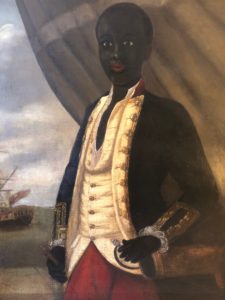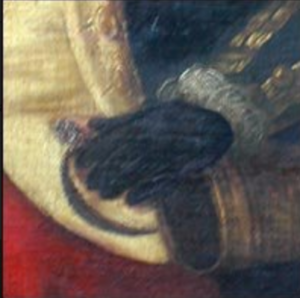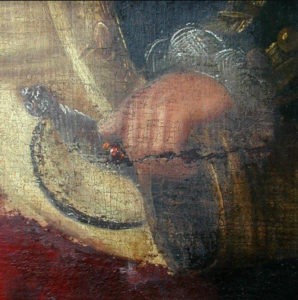In the 1970s, I lived in Newport, Rhode Island, and I had just built full-sized, operational copies of two Revolutionary War ships for the Bicentennial, the 24-gun frigate Rose (that had been sent by the British in 1775 to put an end to Rhode Island’s lucrative rum trade), and the 12-gun sloop Providence (the first ship of the Continental Navy, which had been founded specially to force the Rose to depart Narragansett Bay). Rose is now on permanent display at the San Diego Maritime Museum, after having starred with Russell Crowe in the movie Master & Commander, and Providence is now on permanent display in Alexandria, Virginia.
Sometime in the late 1970s, I had occasion to consult with Newport physician Dr. Alex McBurney about a health matter. He, in turn, mentioned that he had wanted to consult me about an historical painting he had acquired for $1,300 in 1975. He told me that the painting was of a man in a sailor’s uniform that appeared to be from the eighteenth century and that there was also a part of a sailing warship in the painting. I agreed to look at the painting, adding that I knew nothing about brush-work and other painting techniques. My expertise would consist in evaluating the subject of the painting.
What I saw was very definitely a subject from the Revolutionary War that was painted at the time. In the foreground is a common sailor, wearing the reddish trousers worn by many seamen in the Revolutionary War period. However, the sailor is also wearing a fine linen shirt under a white single-breasted waistcoat with gold-colored buttons. Over the waistcoat, the sailor is wearing the blue-white-and-gold coat from a dress uniform of a captain in the Royal Navy from the period of the Revolutionary War. His left hand is touching the hilt of a sword similar to ceremonial swords worn at that time by captains of the Royal Navy. His left hand is also resting on a bronze or brass cannon barrel, that looks to be about a four-pounder. But the cannon is high enough off the ground that it is presumably mounted on a field carriage (like, for example, the four bronze cannons of the Artillery Company of Newport of 1741, the oldest military unit still in service in North America, whose barrels were cast by Paul Revere of Boston; when I lived in Newport, I was a member of the Artillery Company for many years, rising to the rank of major). The cannon was clearly not mounted on a ship’s carriage, which would have made the barrel much closer to the ground.

Painting of the Black Privateer Sailor in its current state, 2020. A Newport Historical Society curator recently informed Christian McBurney that this image is one of the most frequently requested for the Newport Historical Society to provide, even though it does not own it (Christian McBurney)
In the background is a full-rigged, armed ship at anchor. The ship is flying the American ensign that was at that time reserved for non-governmental American ships, meaning either merchant ships or privateers. During the Revolutionary War, privateers received commissions from state governments allowing them to attack and capture enemy vessels (but not those of friendly or neutral nations). The spoils of a capture would be shared by the owners of the vessel and by the officers and sailors of the privateer making the capture. The flag in the painting is simply thirteen red and white stripes, with no “canton” of stars or anything else in the upper corner closest to the staff. The implication, then, is that this heavily-armed ship was a privateer ship.
Dr. McBurney informed me that he purchased the painting at a gallery at Charlestown, Rhode Island. Accordingly, the painting may have had a Rhode Island provenance and was perhaps found in the attic of the house of an old Rhode Island family. If that was accurate, there were only a few Rhode Island full-rigged ships that operated as American privateers in the Revolutionary War. One of them was the 20-gun privateer ship General Washington, built in 1779 in Providence for wealthy Providence businessman John Brown. She measured 98 feet long on deck (about 117 feet long on the hull), and 30 feet beam, with a tonnage of 340.
John Brown, one of four famous brothers in the Providence lucrative rum trade before the Revolution, had owned the 12-gun sloop Katy, which he had loaned to the Rhode Island Navy on June 12, 1775, when it was founded as the first of all the state navies in the Revolution. (Benedict Arnold of Connecticut had taken great initiative and, without authorization from Congress, had personally established “a navy in Continental service” on Lake Champlain as early as late April 1775, before the Rhode Island Navy or the Continental Army or the Continental Navy had been founded, and Arnold had used the Lake Champlain ships to great advantage in the American cause). Three days after the Rhode Island Navy was founded, Katy, commanded by Abraham Whipple, captured the sloop Diana from Royal Navy forces active in Narragansett Bay. A few months later, on 13 October 1775, Katy was the first vessel authorized by Congress for the Continental Navy, and her name was changed at the time to Providence. She became the first to land the American Marines in March 1776, and the first military command of John Paul Jones in May 1776. She was destroyed in the Penobscot Bay, Maine in 1779 to avoid capture.
The privateer General Washington was first commanded by James Munro in 1779, and he used her to capture a British merchant ship called John Barrington, among other ships. Later that year, Munro left the ship to take command of a larger Massachusetts privateer. In 1780, command of General Washington was given to Silas Talbot, who held commissions from Congress as a colonel in the Continental Army and as a captain in the Continental Navy at the same time. In this case, he clearly took a leave of absence from both commissions and acted in a private capacity as commander of the General Washington privateer. He captured two valuable British merchant ships in the summer of 1780, one of which was retaken by the British. Soon after that, a fierce storm descended on the privateer, just as the British 74-gun battleship Culloden and other British warships appeared. In the strong winds, the larger British ships could sail much faster than the smaller American ship, so Talbot reluctantly was forced to surrender.
The ship was taken into the Royal Navy as General Monk, and under Captain Josias Rogers was able to inflict considerable damage on American shipping. In August 1781, she assisted in capturing the 28-gun Continental frigate Trumbull, the last of the original thirteen frigates built for the Continental Navy. However, in April 1782, she and her consorts attacked an American convoy in the mouth of the Delaware River. Young Captain Joshua Barney skillfully commanded the rather puny convoy guard-ship Hyder Ali so as to capture General Monk by boarding. Since his crew greatly outnumbered the British crew, the General Monk was captured and was again an American ship.
The vessel was then taken into the Continental Navy under her original name (at first under charter and later by purchase), and Barney was given command of her. He used her to capture a number of British ships in the Caribbean, to bring a shipment of much-needed gold from Havana back to Philadelphia, and to bring important messages to Ambassador Benjamin Franklin in France. When she returned to Philadelphia, the peace treaty that ended the war was announced, so Barney was detailed to carry an important passenger, John Paul Jones, to England on personal business. She thus became the first United States warship to visit Great Britain after the war was over. Barney gave a lavish dinner party for all the local citizens of Plymouth who had previously assisted him in escaping from the notorious Mill Prison there. In the summer of 1784, she was one of only two ships still owned by the United States Navy, so she was put up for auction and sold – to none other than John Brown of Providence, her original owner.
Brown fitted out the privateer for the Canton, China trade, and she left home in 1787, the first Rhode Island vessel to visit China, under the command of Jonathan Donnison. When she returned two years later, Brown loudly proclaimed that he had lost 500 pounds on the voyage, but Brown’s biographer, James Hedges, revealed that Brown had “fiddled” the books in order to discourage competition. Brown had actually made a handsome $20,000 profit! It was no wonder then that Brown sent her back to Canton within a few weeks. While she was still making voyages to and from Canton, Brown built two additional ships for the Canton trade, the 950-ton 36-gun President Washington in 1790, and the 624-ton 24-gun George Washington in 1793.
To return to Dr. McBurney’s painting, it is possible to develop a narrative behind it. The ship General Washington had captured a British ship on its way to New York City (the main British base in North America during the Revolutionary War). Part of the cargo of that ship included a new dress uniform and sword ordered by a Royal Navy captain stationed in New York. All the crew of the General Washington were awarded shares in the prize money received from selling the British ship and its cargo at a court-ordered auction. This particular sailor used some of his prize money to hire a painter (possibly one of his shipmates) to paint an oil portrait of him, and he likely was able to persuade his captain to lend him the captured uniform and sword for long enough to pose in it for the portrait, but still wearing his own red trousers (presumably, the captured white breeches were the wrong size for him).
The one factor that I have so far refrained from mentioning is that the sailor in the portrait was an African-American. That made the portrait an extremely important and rare find. Very few period portraits of black participants in the American Revolution are known (black men are known to have fought on both sides). When they do appear, they are typically merely background to a picture of a white man or white men.
As soon as word got out about the portrait, Dr. McBurney was asked to lend it to various special exhibitions, and to allow images of it to be published in various magazines and books, and he generously did so. For example, an image of the painting appears in W. Jeffrey Bolster’s Black Jacks: African American Seamen in the Age of Sail (Harvard University Press, 1998). He had the painting insured for $300,000.
In 2006, Dr. McBurney received a request from the prestigious Fraunces Tavern Museum in New York City to lend the painting to a special exhibition arranged by curator Nadezhda Williams, to be called “Fighting for Freedom: Black Patriots and Loyalists.” Dr. McBurney again generously agreed to the request. In preparation for the exhibition, he decided to have the painting cleaned by experts in Boston, led by conservator Peter Williams (no relation). McBurney also said he had started to harbor some doubts about the painting’s authenticity.
While working on the painting, Peter Williams found that the original portrait was actually of a white sailor. He further determined that someone, probably shortly before McBurney purchased the painting, had scraped off most traces of white flesh and replaced it with black hands, chest, and face under short African hair, using very crude technique. Since the features of the original subject had been scraped off, there was no sense in removing the black paint. McBurney had the painting restored to its best condition. The museum was forced to find some other painting for the centerpiece of its exhibition.
Apparently, perhaps during the early 1970s, as the study of black history was becoming to be considered a previously neglected area of American history, someone thought the eighteenth century painting of a white privateersman would be more valuable if he was converted to a black man. However, interestingly, the sale price of the painting in 1975 did not reflect that value. Dr. McBurney had purchased the painting for $1,300 from an art gallery in Charlestown, Rhode Island, whose owner did not appreciate what she had. Presumably, the art gallery owner paid $1,000 or less for the painting.
Peter Williams said in an interview with National Public Radio (NPR) on May 11, 2006 that he admired Dr. McBurney for wanting the truth to be revealed. “He could have kept the secret and sold the painting for a huge profit,” Williams said in the interview.
Said Dr. McBurney in 2006, “He’s an old friend now. For more than thirty years, he’s occupied a position of honor in the dining room, and he’ll stay there.” Ownership of the painting has now passed to Dr. McBurney’s son, Christian, a Rhode Island history author and attorney, and publisher of smallstatebighistory.com.
Newport historian Keith Stokes wrote McBurney that while it is an altered portrait, it still represents the sizeable number of African heritage mariners in eighteenth century America.
[Banner Image: Painting of the Black Privateer Sailor in its current state, 2020. A Newport Historical Society curator recently informed Christian McBurney that this image is one of the most frequently requested for the Newport Historical Society to provide, even though it does not own it (Christian McBurney)]
The story about the unmasking of the painting appeared in The New Yorker, May 7, 2006, “A Painting’s Secret” by Erik Baard. Both this article and the NPR article can be found online with a Google search. For information on the ship General Washington, see James B. Hedges, The Browns of Providence Plantations, The Colonial Years (Providence, RI: Brown University Press, 1952), 284-85 and James B. Hedges, The Browns of Providence Plantations, The Nineteenth Century (Providence, RI: Brown University Press, 1968), 16-20, 22-33, 61, 72, 99 and 157.


























